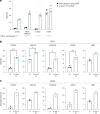Removal of TREX1 activity enhances CRISPR-Cas9-mediated homologous recombination
- PMID: 39134754
- PMCID: PMC12263433
- DOI: 10.1038/s41587-024-02356-3
Removal of TREX1 activity enhances CRISPR-Cas9-mediated homologous recombination
Abstract
CRISPR-Cas9-mediated homology-directed repair (HDR) can introduce desired mutations at targeted genomic sites, but achieving high efficiencies is a major hurdle in many cell types, including cells deficient in DNA repair activity. In this study, we used genome-wide screening in Fanconi anemia patient lymphoblastic cell lines to uncover suppressors of CRISPR-Cas9-mediated HDR. We found that a single exonuclease, TREX1, reduces HDR efficiency when the repair template is a single-stranded or linearized double-stranded DNA. TREX1 expression serves as a biomarker for CRISPR-Cas9-mediated HDR in that the high TREX1 expression present in many different cell types (such as U2OS, Jurkat, MDA-MB-231 and primary T cells as well as hematopoietic stem and progenitor cells) predicts poor HDR. Here we demonstrate rescue of HDR efficiency (ranging from two-fold to eight-fold improvement) either by TREX1 knockout or by the use of single-stranded DNA templates chemically protected from TREX1 activity. Our data explain why some cell types are easier to edit than others and indicate routes for increasing CRISPR-Cas9-mediated HDR in TREX1-expressing contexts.
© 2024. The Author(s).
Conflict of interest statement
Competing interests: J.E.C. is a co-founder and board member of Spotlight Therapeutics, a scientific advisory board (SAB) member of Mission Therapeutics, an SAB member of Relation Therapeutics, an SAB member of Hornet Bio, an SAB member for the Joint AstraZeneca–CRUK Functional Genomics Centre and a consultant for Cimeio Therapeutics. The laboratory of J.E.C. has funded collaborations with Allogene and Cimeio. The other authors declare no competing interests.
Figures





References
MeSH terms
Substances
Grants and funding
LinkOut - more resources
Full Text Sources
Miscellaneous

